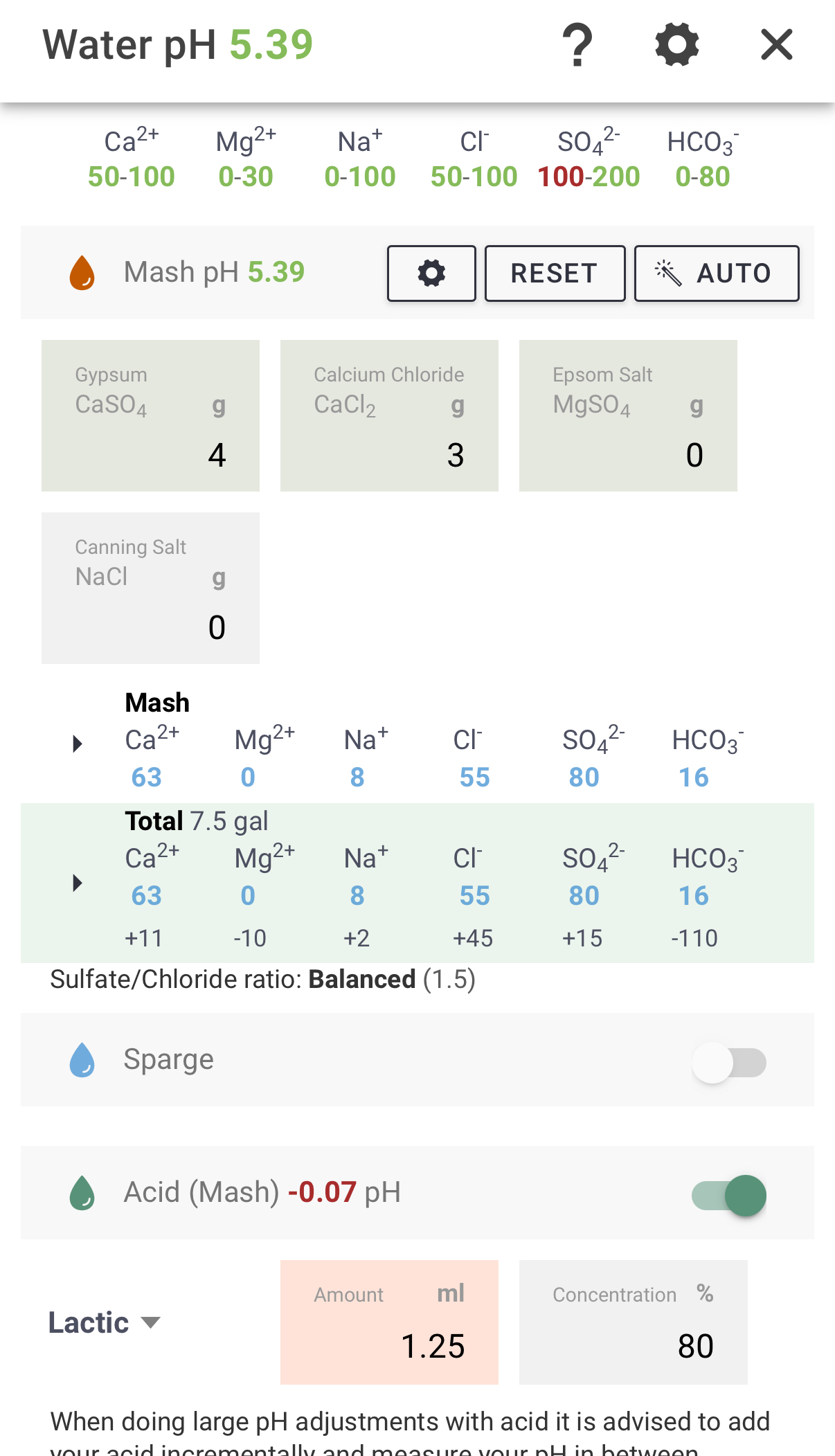hiphoppotamuss
Well-Known Member
Common wisdom over the years seems to indicate that squeezing the heck out of your brew bag does not tend to cause extraction of tannins
Well, Here’s a bitter I recently brewed. It’s good but definitely has a distracting tannin aftertaste. I did brew in a bag method in my 10.5 anvil foundry. No mash pipe. Squeezed the heck out of the bag like I always do. What could have gone wrong and how can I prevent this happening in the future? Definitely drinkable , just puckering.
Anvil Foundry 10.5 220V
72.7% efficiency
Batch Volume: 5.5 gal
Boil Time: 60 min
Mash Water: 7.67 gal
Sparge Water: no Sparge
Total Water: 7.67 gal
Boil Volume: 6.96 gal
Pre-Boil Gravity: 1.046
Vitals
Original Gravity: 1.050
Final Gravity (Fixed): 1.010
IBU (Tinseth): 33
BU/GU: 0.65
Color: 14 SRM
Mash
Strike Temp — 159.3 °F
Mash 1 — 151 °F — 60 min
ph 5.4
Mash Out — 167 °F — 10 min
Malts (10 lb 4 oz)
7 lb (68.3%) — Thomas Fawcett Pale Malt, Maris Otter — Grain — 2.8 °L
1 lb 8 oz (14.6%) — Weyermann Barke Pilsner — Grain — 1.9 °L
8 oz (4.9%) — Wheat Flaked — Grain — 1.7 °L
7 oz (4.3%) — Simpsons Crystal Dark — Grain — 100.8 °L
6 oz (3.7%) — Simpsons Crystal Light — Grain — 39.5 °L
6 oz (3.7%) — Briess Oats, Flaked — Grain — 1.6 °L
1 oz (0.6%) — Simpsons Roasted Barley — Grain — 600.1 °L
Hops (81 g)
18 g (19 IBU) — Target 10.3% — Boil — 60 min
9 g (7 IBU) — Challenger 7.5% — Boil — 60 min
9 g (5 IBU) — Northdown 5% — Boil — 60 min
18 g (1 IBU) — Challenger 7.5% — Aroma — 10 min hopstand @ 165 °F
18 g (1 IBU) — Northdown 8.5% — Aroma — 10 min hopstand @ 165 °F
9 g (1 IBU) — Target 11% — Aroma — 10 min hopstand @ 165 °F
Hopstand at 165 °F
Miscs
3 g — Calcium Chloride (CaCl2) — Mash
4 g — Gypsum (CaSO4) — Mash
1.25 ml — Lactic Acid 80% — Mash
Yeast
1 pkg — Imperial Yeast A09 Pub 74%
Fermentation
Primary — 64.4 °F — 10 days
Secondary — 69.8 °F — 4 days
Carbonation: 2.4 CO2-vol
Well, Here’s a bitter I recently brewed. It’s good but definitely has a distracting tannin aftertaste. I did brew in a bag method in my 10.5 anvil foundry. No mash pipe. Squeezed the heck out of the bag like I always do. What could have gone wrong and how can I prevent this happening in the future? Definitely drinkable , just puckering.
Anvil Foundry 10.5 220V
72.7% efficiency
Batch Volume: 5.5 gal
Boil Time: 60 min
Mash Water: 7.67 gal
Sparge Water: no Sparge
Total Water: 7.67 gal
Boil Volume: 6.96 gal
Pre-Boil Gravity: 1.046
Vitals
Original Gravity: 1.050
Final Gravity (Fixed): 1.010
IBU (Tinseth): 33
BU/GU: 0.65
Color: 14 SRM
Mash
Strike Temp — 159.3 °F
Mash 1 — 151 °F — 60 min
ph 5.4
Mash Out — 167 °F — 10 min
Malts (10 lb 4 oz)
7 lb (68.3%) — Thomas Fawcett Pale Malt, Maris Otter — Grain — 2.8 °L
1 lb 8 oz (14.6%) — Weyermann Barke Pilsner — Grain — 1.9 °L
8 oz (4.9%) — Wheat Flaked — Grain — 1.7 °L
7 oz (4.3%) — Simpsons Crystal Dark — Grain — 100.8 °L
6 oz (3.7%) — Simpsons Crystal Light — Grain — 39.5 °L
6 oz (3.7%) — Briess Oats, Flaked — Grain — 1.6 °L
1 oz (0.6%) — Simpsons Roasted Barley — Grain — 600.1 °L
Hops (81 g)
18 g (19 IBU) — Target 10.3% — Boil — 60 min
9 g (7 IBU) — Challenger 7.5% — Boil — 60 min
9 g (5 IBU) — Northdown 5% — Boil — 60 min
18 g (1 IBU) — Challenger 7.5% — Aroma — 10 min hopstand @ 165 °F
18 g (1 IBU) — Northdown 8.5% — Aroma — 10 min hopstand @ 165 °F
9 g (1 IBU) — Target 11% — Aroma — 10 min hopstand @ 165 °F
Hopstand at 165 °F
Miscs
3 g — Calcium Chloride (CaCl2) — Mash
4 g — Gypsum (CaSO4) — Mash
1.25 ml — Lactic Acid 80% — Mash
Yeast
1 pkg — Imperial Yeast A09 Pub 74%
Fermentation
Primary — 64.4 °F — 10 days
Secondary — 69.8 °F — 4 days
Carbonation: 2.4 CO2-vol





































![Craft A Brew - Safale S-04 Dry Yeast - Fermentis - English Ale Dry Yeast - For English and American Ales and Hard Apple Ciders - Ingredients for Home Brewing - Beer Making Supplies - [1 Pack]](https://m.media-amazon.com/images/I/41fVGNh6JfL._SL500_.jpg)






















